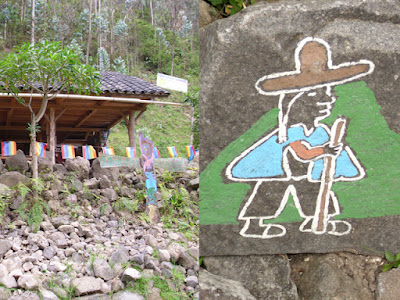Your's Truly at Lago San Pablo. Pijal is the mountain in the background.
Otavalo has become known over the decades for its surreal
open markets.
Chinese knock-off products share stalls with traditional Ecuadorian crafts.
A waxy, roasted pig’s head advertises every lunch counter and dogs kick leftover
bones through the stands of local superfruits.
The market scene in Otavalo on a typical Saturday.
My hiking pal Iona and I launch our day trip from Quito’s
northernmost neighborhood, called “La y” (“the and,”) indicating it’s history
additive to Old Town Quito.
Transferring from the city’s Trolle line, we board a
provincial coach. The total round trip cost is only $7, but one pays a little
bit of that $7 every time one transfers to a new coach (six times), so it is
wise that we are carrying change in coins.
Though the travel time is advertised as two hours, the trip
north takes almost three as the coach stops for a seemingly endless array of
non-paying Otavaleño passengers and food vendors.
Once in Otavalo, it is clear the principal experience is
actually having made the pilgrimage on a Saturday.
My hiking companion, Iona, in front of Otavalo's Town Hall.
Many Otavaleños “made
good” in Quito return, wearing their native costumes and to be a part of the
community ritual.
Unlike other parts of Ecuador, where a man like me with long hair stands out, I appear to be emulating the Otavaleños on the day of my visit.
It is traditional for Otavaleño men to grow their hair long, and wear it in a pony-tail or braid it. Of all parts of the regional costume, the men's manner of wearing their hair may be the solitary pre-Columbian element.
The preservation of this tradition is so revered that Otavaleño men may keep their braids if they elect to join the military in Ecuador.
Since all the goods available in Otavalo can be purchased
conveniently at similar prices elsewhere, we spend little time at the busy market.
We decide to journey 4K southeast of town to the natural
attractions around Lago San Pablo.
Iona alongside Lago San Pablo. Volcan Imbabura in the distance.
Lago San Pablo is unusual for a number of reasons.
First, there is a algae-like mold in the marshes surrounding
the lake that is unique to the area. It was created when lava flow from Volcan Imbabura
blocked the lake’s natural drainways.
Second, the lake is home to the Andean climbing catfish.
The
fish use their tail and mouth to climb rocks. The fish likely migrated by land down from the
higher elevations to Lago San Pablo using these unique skills!
Third, the cane from the lake provides raw materials for the
local artisian speciality: mat weaving.
When we visit, two older women are actively harvesting the
cane to take home and braid.
We make our way around the lake and spot several different
paths relevant for hiking off into adventure.
The locals people are very friendly and quick with a kind word or helpful information. They are also enjoying their Saturday. Three brothers spend a considerable amount of time on logistics before we watch them attempt to ride the a bicycle all at the same time.
Ultimately, the back road to Peguche is the one we stumble up.
Two views of the Peguche falls.
One woman is standing on the banks using the water from the falls to help plait her daughter's hair.
On the path running along the falls, I spot a kind of mountain rhubarb with numerous red hairs and chuquiragua flowers.
Local flora includes relatives of raspberry and allium as well as eucalyptus and chiquiragua.
Many people expect this region to have a tropical, jungle
climate, but Otavalo and environs are semi-arid. Pampas grass, agave, and
eucalyptus grow here.
Our options for crossing to the business end of the falls are a large felled tree or a rickety suspension bridge with missing slats. We wisely take the bridge.
The sign for this bridge discouraged visitors from jumping while walking across, apparently the cause of some missing wood slats.
The Peguche artisan village is meant to showcase local weaving,
but it is essentially another point-of-sale for
inexpensively made semi-authentic souvenirs.
Painted rocks and placards at this structure explain the native ritual of Yamor, an annual cleansing in the falls.
While it is likely that many of the flutes and seed jewelry
was created locally, I examine a charango which seemed typical of the
available items. The instrument is strung with monofilament to perform as a
child’s toy and spraypainted with a stencil of Spongebob Squarepants.
Iona makes a purchase: roasted plantain and corn-on-the-cob from an open fire.
Yours Truly and a reconstructed, pre-Columbian stone circle.
An oddity I enjoy in the village area is an unmarked, unexplained
pre-Columbian ruin.
From information gathered online, I understand that the most of the cobblestones on the ground are original, but that the walls and alcoves have
been almost entirely reconstructed.
Hopefully, the same interests that reconstructed the stone
circle will see to it that some kind of signage or marking can be established
to give tourists a greater appreciation of its significance.










No comments:
Post a Comment